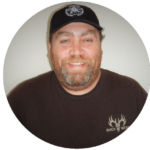The K’ómoks Guardians, established in 2014, monitor, restore, document, patrol, and protect their territory and all the species therein. Their work sustains the ecosystem, protects cultural values, and supports the K’ómoks people.
K’ómoks Guardians: Caretakers for the Land of Plenty
Estimated Reading time

52 Mins
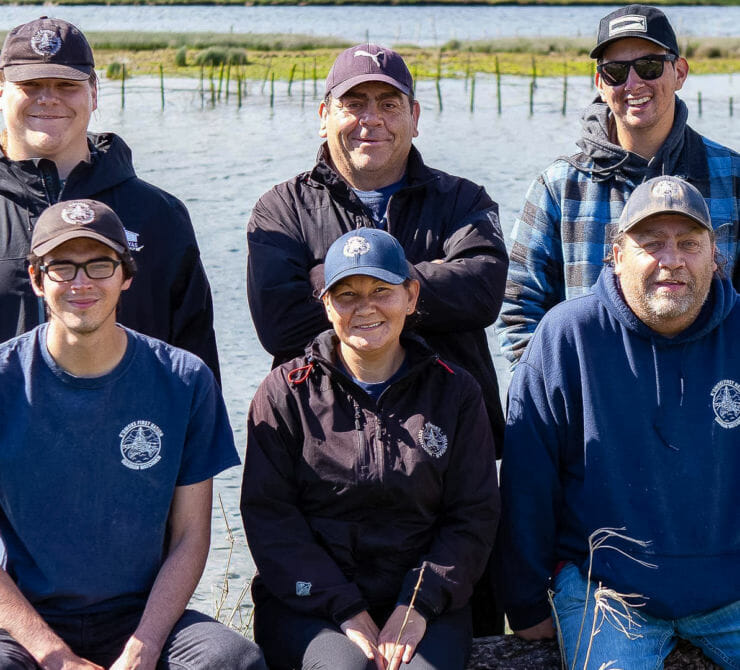
The K’ómoks Guardian Watchmen department is based in the Comox Valley on the territory of K’ómoks First Nation.
At a Glance
K’ómoks First Nation has stewarded the lands and waters of their vast territory since time immemorial. Today, that ancestral responsibility is carried out largely by the K’ómoks Guardian Watchmen department.
Established in 2014, the K’ómoks Guardians monitor, restore, document, patrol, and protect their territory and all the species therein. Their work sustains the ecosystem, protects cultural values, and supports the K’ómoks people.
Though the department has grown extensively over the years, now employing seven full-time staff, there is still much the Nation hopes to achieve. In a region of intense development and urban growth, K’ómoks is fundraising to grow and enhance its stewardship authority. In doing so, they will benefit current and future generations of K’ómoks by enhancing their path to self-determination.
Carefully Stewarding the ‘Land of Plenty’ Since Time Immemorial
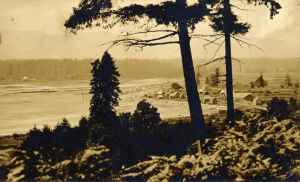
The lands and waters of K’ómoks First Nation are vast and abundant. Along the east coast of what is today known as Vancouver Island, K’ómoks’ territory stretches from Kelsey Bay in the Sayward Valley, across to the mainland coast, and south past Hornby and Denman Islands. It is a region rich with vital watersheds, from the Salmon River in Sayward to the Puntledge River, known to the K’ómoks as the “Land of Plenty.”
Since time immemorial, their lands and waters have provided salmon, herring, duck, shellfish, berries and so much more. In return, the K’ómoks applied harvesting, preparation, and cultivation techniques to ensure the well-being of their environment and people.
“Since the beginning of time First Nations have had an intricate physical and cultural connection to the land,” says Hegus Nicole Rempel, K’ómoks Chief Councillor. “It guided us in everything we did: where we lived, what we ate, when we lived there. And that’s why the land is so important to us. All of our traditional knowledge, culture, and spirituality is connected to the land.”
Since the beginning of time First Nations have had an intricate physical and cultural connection to the land.

After millennia of careful stewardship, the Land of Plenty held great appeal to settlers arriving from Europe. Colonization forced neighboring Nations and tribes together onto small reserves—the K’ómoks Nation today is comprised of descendants of Pentlatch, Lekwiltok, and the five K’ómoks tribes (the Sathloot, Sasitla, Leeksun, Cha’chae, and Tat’poos). Subsequent colonial policy and practice brought great suffering to the K’ómoks people including the loss of land, resources, and cultural connection.
But the K’ómoks people resisted, and today, the Nation has developed a comprehensive community plan, is undergoing treaty negotiations, and is building a diverse economic base. In 2020, K’ómoks First Nation, in partnership with Na̲nwak̲olas Council and Coast Funds, developed a 10-year stewardship vision to guide stewardship revitalization.
The stewardship vision is a continuation of stewardship revitalization efforts that have been underway for decades. “Stewardship never went away from the K’ómoks First Nation perspective,” says K’ómoks Councillor Richard Hardy. “With regards to our authority, jurisdiction, governance, and management of the resources within our traditional territory, it has never gone away. But we’d like to re-establish those aspects and get federal, provincial, and local governments on board.”
One of the most critical elements of stewardship for the K’ómoks First Nation began in 2014 with the development of its Guardian Watchmen department
Revitalizing Stewardship with the K’ómoks Guardian Watchmen Department
Today the Land of Plenty is also a land of development, resource extraction, recreation, and urban growth. Within K’ómoks territory lies the Cities of Campbell River and Courtenay, the Town of Comox, the Villages of Cumberland and Sayward, and communities on Denman and Hornby Islands.

Immense aquaculture, tourism, recreation, and forestry infrastructure has been developed throughout K’ómoks territory, including 51 shellfish and aquaculture sites, 48 marinas, 11 lodges, 120 marine industrial sites, 68 log handling tenures, 129 recreation sites, and 12 concrete or steel dams.
In 2014, K’ómoks leadership determined to develop a Guardian Watchmen Department to sustainably manage the lands, waters, and wildlife within their territory; support their ongoing treaty process; centralize naturalize resource management under one department; and provide employment opportunities to K’ómoks members.
“Our Guardians are our eyes and ears on the lands, waters, and resources,” says Councillor Hardy. “They’re monitoring activities, they’re creating co-management between K’ómoks and local, provincial and federal governments.”
Our Guardians are our eyes and ears on the lands, waters, and resources. They’re monitoring activities, they’re creating co-management between K’ómoks and local, provincial and federal governments.
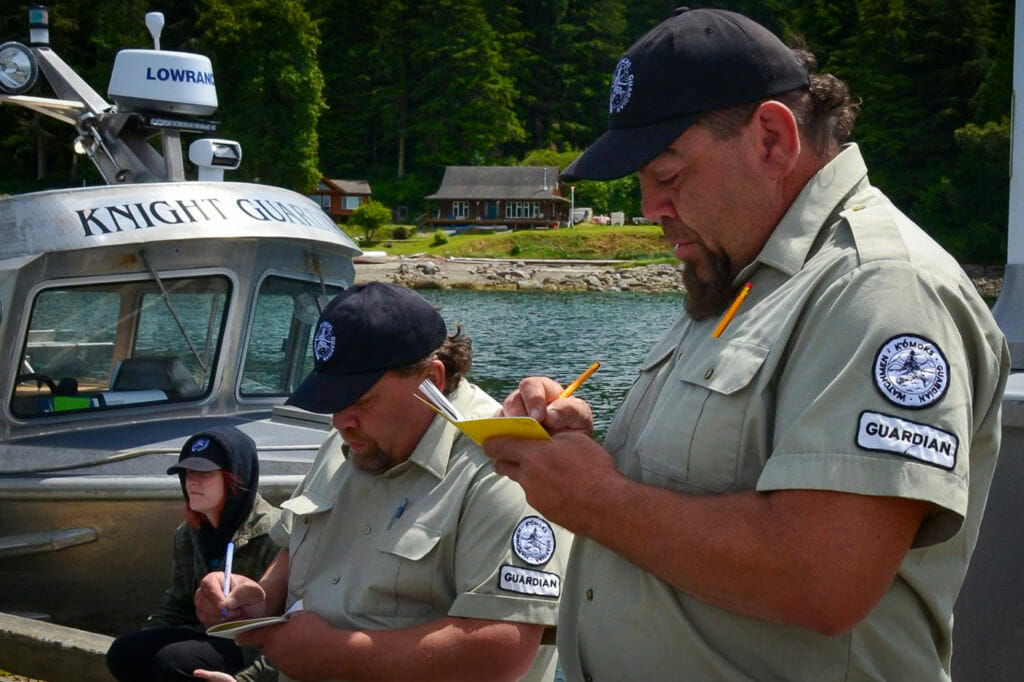
Modelled on coastal Guardian departments, including the Gwa’sala-‘Naxwaxda’xw Guardians, the department began as a pilot project in 2014 with funding through Coast Funds’ conservation fund.
Cory Frank has been around since the start of the K’ómoks Guardians. Today he is the department manager and in 2014 he started as a member of a small team—three Guardians including Cory, his brother Randy, a third Guardian Tony Billy.
Seven years later, Cory enjoys reflecting on the growth of the department since their first pilot year. “In our department, it’s absolutely huge growth,” he says. “We’re up to seven Guardians from that original three.”
The first year was a year of learning for the Guardian department. In that first year alone, the Guardians completed training in small vessel operations, swift water rescue, marine first aid, and more. Two Guardians also completed the stewardship training program offered through Vancouver Island University in partnership with Na̲nwak̲olas Council.
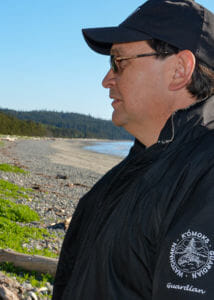
Growth of K’ómoks First Nations’ stewardship endeavours goes beyond the size of its staff, says Scott Harris, resource planner for Na̲nwak̲olas Council. Scott works as part of the Ha-ma-yas Stewardship Network supporting the stewardship efforts of five member First Nations, including K’ómoks. He’s seen K’ómoks’ self-determination enhanced by growing their stewardship efforts. “Now they’re able to participate and to be strong and forceful in the protection of their values,” says Scott. “They’re operating on a government-to-government level and taking advice from stakeholders, instead of being seen as stakeholders. The government is really starting to understand that relationship.”
Councillor Hardy points to forest practices as one case study of where Guardian efforts have directly impacted K’ómoks authority and ability to have government-to-government conversations. On private land, forest codes state that harvesting can take place up to five metres of a shoreline, a much narrower limit than the 50-150 metres required on crown land.
“We started looking at the impact of those practices on fish habitats, on groundwater, and surface water and saying to provincial cabinet ministers, ‘we need some changes to your forest practices,’” says Hardy. “We could point to the work the Guardians were doing and share what they’re finding. The work that gets shared with us from the guys out in the field helps us have those conversations.”
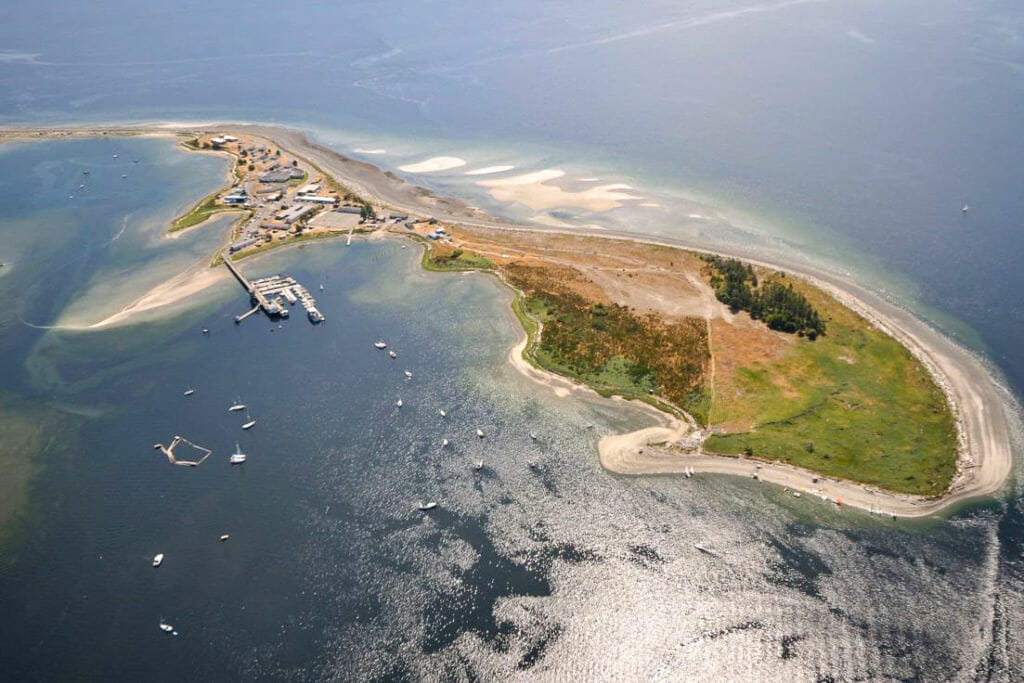
Learning from Elders, Inspiring K’ómoks Youth
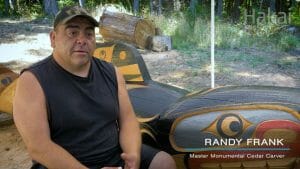
Essential to the success of the pilot project was the Guardians’ relationships with K’ómoks Elders. In that first year, the Guardians consulted extensively with Elders, seeking their knowledge and advice on stewardship of the territory.
As a result of that consultation, K’ómoks developed the Guardian Pole Plan. The plan would see Guardian poles carved and placed throughout K’ómoks territory to create a stronger sense of community and pride, and educte non-Indigenous people about K’omoks values. Guardian Randy Frank, along with Karver Everson worked under the mentorship of master Kwakwaka’wakw carver, Calvin Hunt, the pair are carving and raising Guardian poles at a rate of two per year over a decade, including outside the Comox Valley Arts Gallery.
Maintaining relationships with K’ómoks Elders continues to be an essential element of stewardship. Guardians work closely with Elders to ensure they are caring for the territories in a way consistent with ancestral knowledge. To facilitate discussions, the Guardians often host feasts. “We do a big dinner with traditional foods,” says Cory. “It’s great because that way I get to teach my department how to handle the fish, how to properly clean and prepare it.”
We get to bring the youth in, teach them, and inspire them to want to be environmental stewards themselves.
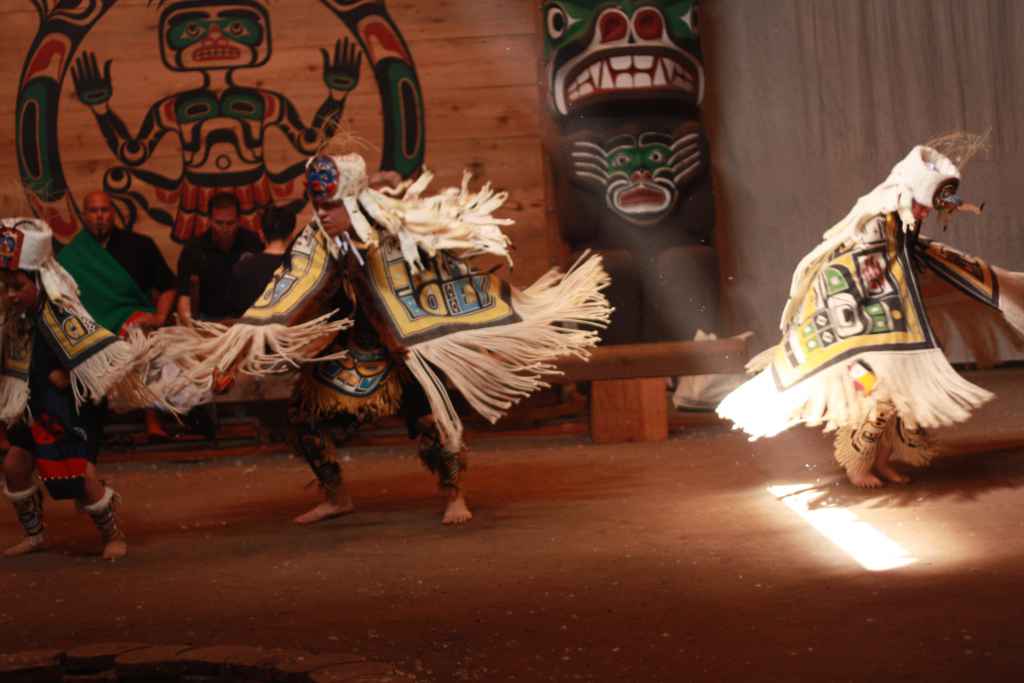
Reflecting on his own childhood and the relationships he and his brother built with Elders, Cory says, “We were taught as kids: you look after your Elders first and then your family. We’ve always had a great relationship with all our Elders. And that’s what I’m trying to get to with all my other staff.”
At the dinners, Guardians create a comfortable atmosphere by serving food, conversing in small groups, and even sharing photo slideshows from work conducted throughout the territory. “The more you can do to make them think about an area of their childhood, it opens their brains up for being able to remember things to tell you,” says Cory. “You’d be amazed at how much you learn just having a casual conversation with an Elder.”
On the other end of the age spectrum, the K’ómoks Guardian department is immensely popular with local youth. The Guardians spend time in schools talking about their work and K’ómoks’ history and connection to the land.
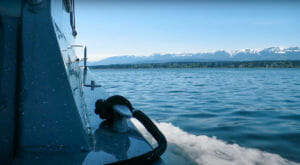
At a graduation ceremony for the Stewardship Technicians Training Program, K’ómoks Guardian Krissy Brown says she’s grateful to work for her Nation in large part because of that educational component. “We get to bring the youth in, teach them, and inspire them to want to be environmental stewards themselves.”
The Guardians have been so successful in inspiring K’ómoks youth that they have been able to hire all their existing staff from its summer student program. Caelan McLean was the first summer student to work with the K’ómoks Guardians. From the age of 16 he worked summers with the department and began working full-time with the team in June of 2018.
“The first summer out there I fell in love with the job,” he recalls. On his very first day he remembers seeing whales in Union Bay and later he joined a week-long Guardian gathering on Compton Island learning about all the types of fieldwork he’d be doing that summer. “I was really lucky. I was the only youth with them, so I got to learn plenty.”
Eco-cultural Restoration and Enhancing Salmon Habitat
One of the projects Caelan and the other K’ómoks Guardians have been working on is protecting and restoring the K’ómoks Estuary from damage done by invasive non-migratory Canada Geese.
The geese were introduced to the Comox Valley as juveniles in the 1970s by hunters, but because adult geese were not brought in at the same time, the young geese never learned to migrate. The geese are immensely destructive to the plants of the estuary. “It’s a huge problem,” says Cory. “They can destroy in a few minutes what could take decades to restore.”
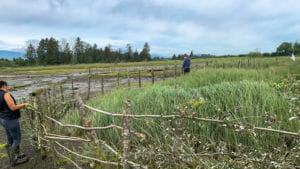
Caelan says one of the biggest targets of the geese is carex grass (Lyngby’s Sedge or carex lyngbyei) that grows in the estuary—up to 1.5 metres tall in some places—and provides shade, shelter, and food for juvenile salmon.
“Salmon are the lifeblood of many Aboriginal communities, and without the habitat to help sustain salmon stocks as they migrate to the estuary, we will all suffer in the decline of these stocks,” Cory Frank said in an article about the restoration work.
To protect the salmon habitat, the Guardians have fenced off parts of the estuary in a traditional design using young alder to hold the fencing in place. The fencing keeps geese from the estuary and allows plants like the sedge and arrow grasses to return.
Salmon are the lifeblood of many Aboriginal communities, and without the habitat to help sustain salmon stocks as they migrate to the estuary, we will all suffer in the decline of these stocks.
The estuary restoration work was conducted with Mid-Island Estuaries Society. The Guardians also work with the Society to harvest geese along the east coast of Vancouver Island. “We go from Sydney and Victoria all the way to Campbell River,” says Caelen. “We distribute meat among all the Nations we stop at along the way.”
The harvest controls the population of the introduced species and, in addition to food, it provides down for First Nations. “It’s really hard to get eagle down these days, so the goose down can be used for ceremonial stuff,” says Cory. “We try and utilize as much as we possibly can and not waste anything.”
The work in K’ómoks estuary is just one of the many habitat restoration project the Guardians are carrying out. Their territory is brimming with significant watersheds critical to the well-being of spawning salmon.
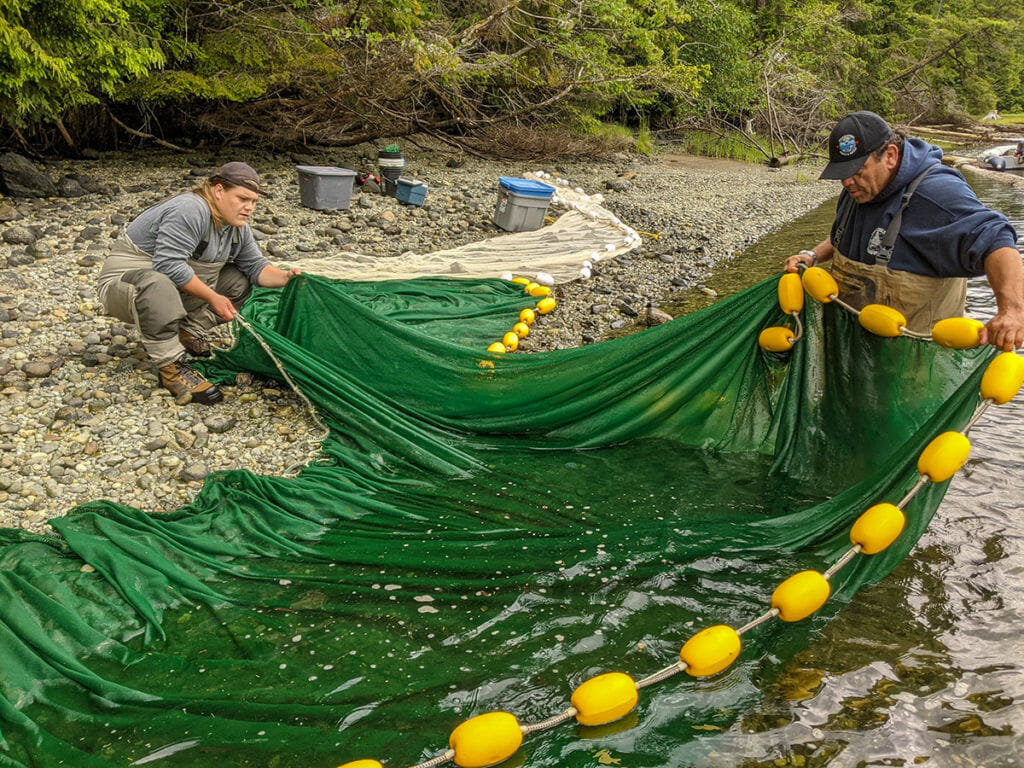
Following a landslide on Dove Creek, the Guardians built a gravel trap and removed 26 dump truck loads of gravel that would have otherwise ended up in the Tsolum River. At Roy Creek, the Guardians constructed a natural culvert to create an access stream for spawning salmon. Within a month Coho salmon had returned to spawn.
With limited resources, the K’ómoks Guardians are narrowly focused on core areas for habitat restoration within the Land of Plenty. But there is still a great need to restore both marine and terrestrial areas that have suffered the impacts of forest harvesting, commercial fishing, and aquaculture.
Growing the Guardian department, as outlined in K’ómoks ten-year stewardship, vision means more ability to enhance and replenish salmon stocks and the habitats that are needed for healthy juvenile salmon to survive.
“I see our Guardians being quite involved in management of not only the K’ómoks estuary, but there’s a number of estuaries throughout the Baynes Sound area right down to Englishman River falls,” says Councillor Hardy. “Of course, the funding and the resources for that department down the road is really important.”

Partnerships in Collaboration

Many of the habitat restoration projects—and much of the other work done by the Guardians—are carried out through partnerships with local restoration and environmental organizations—there are nearly 30 stewardship groups in the Comox Valley alone. The work gets done more effectively when groups work together, and it means fewer organizations competing for the same financial resources.
“I coined the phrase ‘partnerships in collaboration,’” says Cory. “Because we’re here—we’re not going anywhere, they’re not going anywhere. So, let’s get together.”
The partnerships are an effective way to work with local groups and government agencies, but they also cover funding shortfalls. “We basically just hire ourselves out,” Cory laughs. “That’s sort of where we get our funding for half the stuff we do.”
I coined the phrase ‘partnerships in collaboration,. Because we’re here—we’re not going anywhere, they’re not going anywhere. So, let’s get together.
One of the biggest partnerships for the Guardians is working with Project Watershed to revitalize the K’ómoks estuary. As part of that work, K’ómoks First Nation is collaborating on the Kus-kus-sum project. The project will reclaim the old Field sawmill industrial site which is situated on the banks of the Courtenay River, and will return it to a vibrant and productive habitat connected to Hollyhock Flats and the K’ómoks estuary.
Kus-kus-sum is in the heart of a salmon migration corridor, says Project Watershed biologist Jennifer Sutherst. “All the salmon stocks that are returning to spawn as adults in the Tsolum River watershed or the Puntledge River watershed have to migrate past that site,” says Jennifer. “We want to turn this back into an ecological asset.”
In a memorandum of understanding between the City of Courtney, Project Watershed, and K’ómoks First Nation, Hegus Nicole Rempel pointed to the significant of restoring Kus-kus-sum. “K’ómoks First Nation’s interest in the site is largely based on its strong cultural significance,” says Hegus Rempel. “Being stewards of the lands and waters, it is inherently our duty to restore and assist in the rehabilitation of the natural habitat of the salmon and various marine and wildlife in this area. It is our hope for the future that our skilled Guardian Watchmen participate in the restoration and maintenance of the site for our future generations.”
Driving success through the Ha-ma-yas Stewardship Network
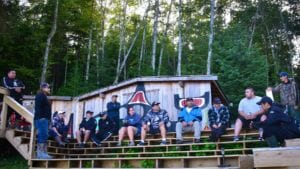
One of the relationships that drives the K’ómoks Guardian department is its membership in Na̲nwak̲olas Council and the Ha-ma-yas Stewardship Network.
The Ha-ma-yas Stewardship Network provides coordination and support for each member Nations’ Guardian departments. The goals of Ha-ma-yas are for First Nations to achieve greater control and management of their territories; to ensure cultural resources and sites are protected; and to increase community well-being and capacity building.
“It’s crucial for First Nations to develop their stewardship authorities to help them regain control of how their lands and resources are managed, occupied, used, and developed,” says Dallas Smith, President of Na̲nwak̲olas Council. “Without having those guardians as boots on the ground, we just don’t have the oversight to help build policy around. It’s vital to have our own eyes and ears out there.”
“It’s been really good,” Cory says of the working relationship. “Na̲nwak̲olas has been a great partner for getting us going and getting us out there.”
As a member of the Ha-ma-yas Stewardship Network, the K’ómoks Guardians have participated in some impressive projects. They have been investing in and developing a research partnership with the BEAR ID PROJECT that is developing face recognition software to identify individual grizzly bears. Guardian Watchmen from Na̲nwak̲olas member Nations have set up over 50 cameras in their territories and that data will also be shared with the BearID project. For Cory, it was a memorable project, “That was one of my favourites.”
It’s crucial for First Nations to develop their stewardship authorities to help them regain control of how their lands and resources are managed, occupied, used, and developed.

Working with the BearID project is just one of the ways Na̲nwak̲olas member Nations are seeking to steward their territories. “It really is a whole ecosystem of research,” says Smith. The research being done by Guardians and the BearID Project is furthering land use planning by Na̲nwak̲olas member Nations. “The data from those cameras is going to help us understand these animals, it’s going to help with grizzly bear management.”
This sort of research capacity is something First Nations have been working to build for years. “We were tired of waiting for other sources of support,” says Smith. “Now we’re building our capacity to do what we need to do.”
Fundraising efforts being led by First Nations are a way Na̲nwak̲olas and its member Nations are growing their capacity to steward their territories. “What these Guardians are doing is super important and its contributing to their well-being,” says Scott. “To increase their stewardship finance at Coast Funds is so important because it will stabilize their funding needs so they can operate on a sustainable, long-term basis.”
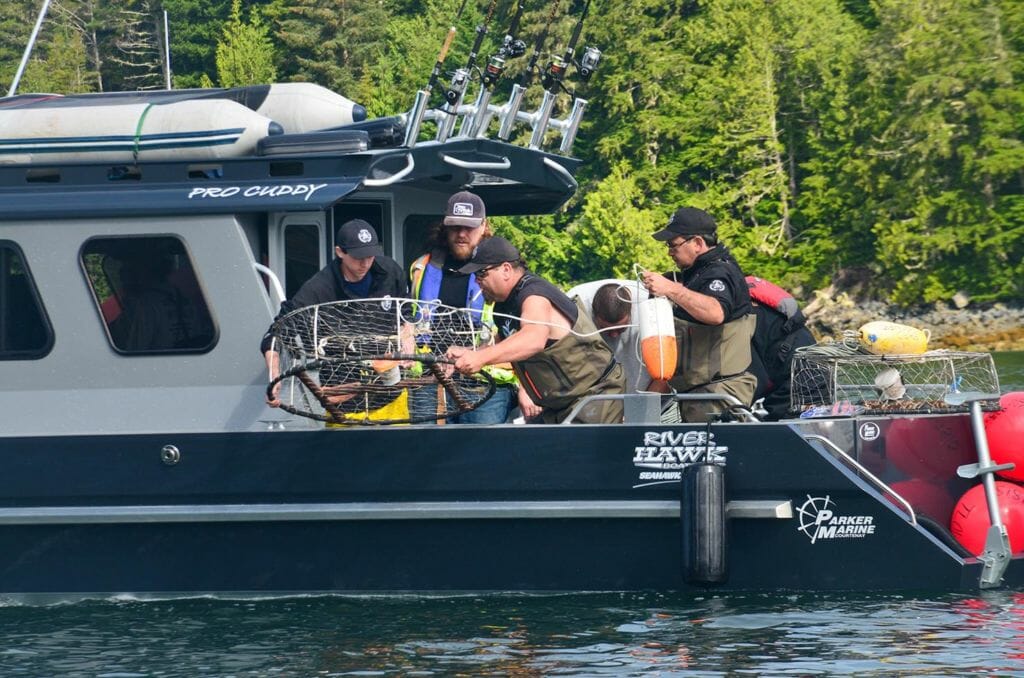
Protecting Cultural Sites and Connecting to the Past

One of the bigger projects the K’ómoks Guardians undertake with Na̲nwak̲olas Council is mapping and re-assessment of archeological sites throughout their territory. “We’re going over sites that were recorded in the 50s, 60s, 70s and verifying what it says in the archeology books,” Cory says. Significantly, the Guardians find that “more often than not” the archeological areas are bigger than what was recorded in the past.
The archeological work strengthens K’ómoks’ connection to place, history, and culture. Visiting sites and determining their level of vulnerability to disturbance provides Guardians with a sense of purpose and pride in understanding who they are and where they come from. Guardian Caelan McLean affirms the importance of the work: “We see all the historical features that are still on our territory. And we’re sort of the end of the line, keeping our eyes on it and preserving it. We’re the present of our history.”
We see all the historical features that are still on our territory. And we’re sort of the end of the line, keeping our eyes on it and preserving it. We’re the present of our history.
Between 2017 and 2019, the Guardians assessed and updated 93 sites (more than 10% of the known sites recorded in the Provincial archeological database). The database that K’ómoks is building with Ha-ma-yas Stewardship Network provides leadership with accessible information to inform resource referral decisions and support treaty negotiations.
During the pandemic, Na̲nwak̲olas developed an online database for each Nation to easily access their data at their convenience. The team moved all the archeological GIS data online so that each Nation can pull up their information at their own convenience. “We thought, how can a central organization like Na̲nwak̲olas make sure we get the data into the hands of those collecting it,” says Scott. “Now they can pull it up any time they need.”

Another project the K’ómoks Guardians are working on is with archeologist Dr. Jessie Morin. Together, they completed fascinating archeological DNA (aDNA) work. The Guardians collaborated with Dr. Morin to analyze part of an ancient fish weir from the K’ómoks harbour. Their research demonstrated the weirs as “a sophisticated technology that was used to sustainably harvest salmon for centuries.”
Future work with Dr. Morin will undertake aDNA work that can support oral histories of the K’ómoks culture and past by analyzing ancient salmon bones. “You can get a picture of how people lived back then, when and how they fished. You can determine whether they were targeting just the males of certain species and letting all the females go,” says Cory. “It’s pretty amazing.”
A big part of doing the archeological work and other projects that get the K’ómoks Guardians travelling throughout their territory is growing recognition among those who live on K’ómoks territory. “When we’re out there the outside community is seeing us actually walk the walk,” says Cory. “And that’s becoming very important.”
Today the Guardians get around 15-20 calls a week reporting activity that might be of concern. “The relationship between our Nation and our outside community, that’s been absolutely amazing.”
Enhancing Resilience in the Face of Climate Change

As a coastal First Nation concerned about the well-being of future generations, K’ómoks First Nation places great emphasis on assessing and mitigating climate change impacts. A changing climate affects the Nations’ food security resource management, and cultural connection to the territory.
“I think there’s a lot of work to be undertaken in regard to climate change,” says Councillor Hardy. “We need to understand where we are today so in ten years we have a baseline understanding of where we are and where we’re going from a climate change perspective and a sea level perspective.”
Along with other Na̲nwak̲olas Council member First Nations, K’ómoks Guardians are partnering with The Nature Trust of BC on researching these impacts. A five-year project called “Enhancing Estuary Resilience: Sustaining Fish and Fish Habitat in a Changing Climate” is currently underway.
Having people who know the territories inside out, who are competent in boats in these places and who understand how the tides work and the tough conditions is priceless.
The project aims to study key estuaries on the coast to better understand their resiliency to the changing climate. As Na̲nwak̲olas notes, “estuaries are transition interfaces between the marine and freshwater environments that are critical to so many different species including salmon, bears, birds and plants.”
The K’ómoks Guardians are also conducting kelp and eelgrass surveys throughout their marine territory. “They’re quite important because those two species are slowly disappearing,” says Cory. Kelp and eelgrass are species that indicate the well-being of a marine ecosystem, so the research is an important part of planning and implementing an ecosystem-based management (EBM) framework.
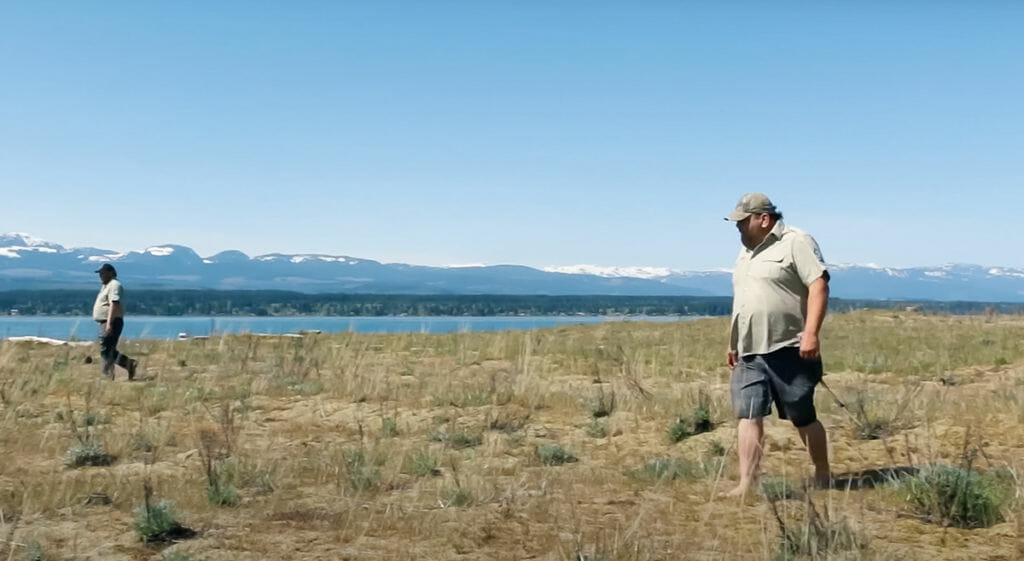
The research conducted by K’ómoks and others is helping to determine what impact climate change and other human activities like logging and fish farming might have on the ecosystem. Guardians play an essential role in the research, says Dr. Rebecca Martone, a marine conservation scientist. “It’s pretty challenging to monitor species that are mostly underwater, in remote locations with difficult access,” Martone says. “Having people who know the territories inside out, who are competent in boats in these places and who understand how the tides work and the tough conditions is priceless.”
Another area of research related to climate change impacts is environmental DNA (eDNA) research being conducted by the K’ómoks Guardians and other Na̲nwak̲olas member First Nations. The work involves collecting water samples and testing the DNA of organic matter found in those samples. “It’s a new way to understand the biodiversity in key habitats,” says Jordan Benner, Na̲nwak̲olas Forestry and Research Adviser, in an article about the work. Jordan notes the ability to conduct eDNA research will fill gaps in knowledge about what species exist in key watersheds. “There’s a lot of missing data in the watersheds. With eDNA, we can start to get a better understanding of which organisms are in in what area.”
The research will give insights into the adaptability of species like salmon to changing climates, according to Sue Velazquez who leads eDNA research with Hakai Institute. “As fish respond rather quickly to environmental changes, analysis of fish eDNA to look at fish biodiversity will be a useful tool to help us monitor the health of the environment and impacts of climate change,” says Sue.
K’ómoks Stewards Vision: Revitalizing Ancestral Responsibilities to the Lands and Waters

But Cory is the first to acknowledge there’s more he’d like his department to be doing. “I’d like to see my department get to the point where I have sub-departments—one for archaeology, one for habitat restoration and so on,” says Cory. “I’d like to start specializing my staff and what they do so they’re not having to bounce all over the place all the time.”
Working with Na̲nwak̲olas Council and Coast Funds, K’ómoks First Nations has developed a ten-year stewardship vision and is fundraising to grow self-determined stewardship finance. Relying on discrete funding from grants has kept the Guardian department operational over the years, but there are challenges that come with it too.
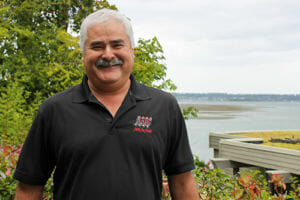
Having stable own-source revenue means the Nations can reliably plan their seasons, retain staff, and grow their stewardship authorities. “If we can increase that endowment, it would take the pressure off having to chase funding with strings attached. It would allow the Nations to settle in and establish their departments and grow their full-time staff.”
Growing the K’ómoks Guardian team to become a multi-disciplinary, multi-faceted stewardship authority operating throughout the territory as it outlines in its stewardship vision means K’ómoks can uphold the rights and responsibilities to steward their territory in a manner that sustains the ecosystem, protects cultural values, and support its people in perpetuity.
The Guardian department aims to grow to ten full-time team members and several seasonal staff. It would operate out of both K’ómoks and Sayward to cut down on travel, which can be hard on equipment and staff.
Stewardship is intimately tied to K’ómoks self-determination, and it supports the Nation to assert its title and rights, including working to develop stronger land and resource governance and related management and technical capacity.
I think we take a lot of pride in the work that our Guardians do, but it’s not just for our community. It’s for the locals within the Comox Valley, it’s for British Columbians, it’s for Canadians.

“Like most First Nations in Canada we are considered wards of the crown,” says Hegus Nicole Rempel in a K’ómoks Treaty video. “Through the modern treaty process we are negotiating to become self-determining and determine our own collective future together.”
Along with growing the department, the Nation aims to regain the authority to enforce its laws in the territory. Currently, Guardians are only able to record and report infractions to Provincial or Federal government authorities. “We want to help protect and preserve things that are important to us, and important to the whole outside community,” says Cory. “We’d like to be able to do enforcement along with these other government agencies.”
The benefits of enhancing K’ómoks stewardship authority spin well beyond the boundaries of its traditional territory. The work the Guardians undertake benefits not only the K’ómoks First Nation, but provide a service for a much broader public. “I think we take a lot of pride in the work that our Guardians do, but it’s not just for our community,” says Councillor Hardy. “It’s for the locals within the Comox Valley, it’s for British Columbians, it’s for Canadians.”
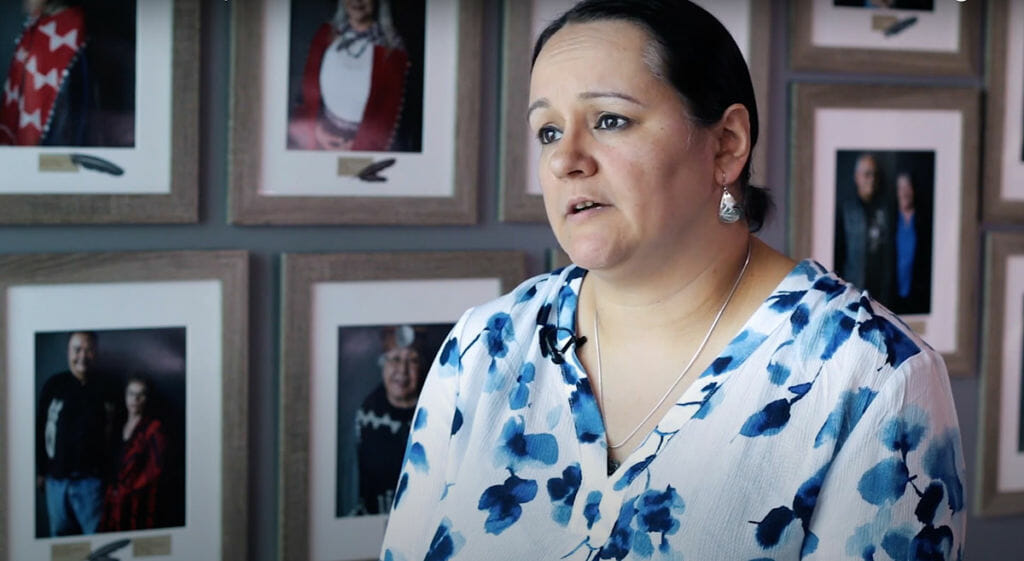
Lessons Learned
After six years of operation, the K’ómoks Guardians have had an immense impact on the well-being of their territory and their community. Overcoming challenges is a daily part of the job for Cory Frank and the rest of the K’ómoks Guardians. Over the years, Cory has learned a great deal that has helped his team be successful.
Working in Partnerships
The Ha-ma-yas Stewardship Network and K’ómoks’ working relationship has been essential to the success of the Guardians. Na̲nwak̲olas provides critical supports for the Guardian department and ensures access to essential training.
Additionally, the K’ómoks Guardians have formed partnerships with dozens of government agencies and local stewardship groups to ensure staff can complete their priority initiatives each season.
Many of these partnerships provide the Guardians with access to training and skill building. “We’ll often go out to get training from outside agencies that are willing to pay to bring us in and train us in what they do,” says Cory.
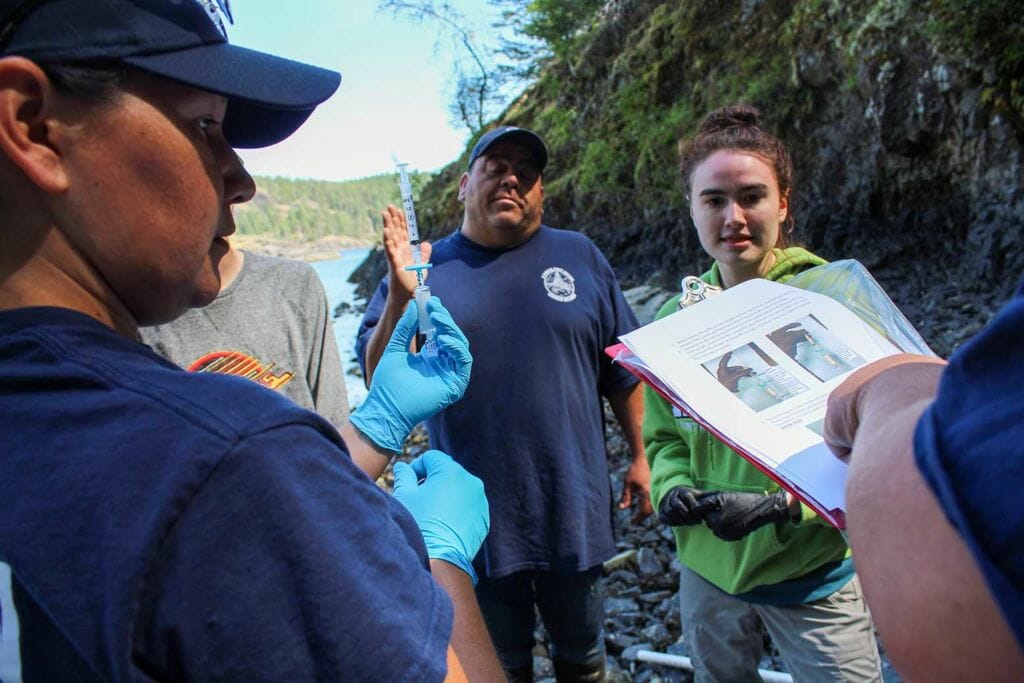
Building Connections in the Community
The K’ómoks Guardian department prides itself in undertaking significant outreach throughout K’ómoks territory. Each season Cory and his team spent time at local schools teaching them about the Nation’s historic and current relationship to its lands and waters. The amount of time the Guardians have spent interacting with schools has created significant interest from youth.
But the Guardians don’t limit their outreach to students. Engaging visitors to the K’ómoks territory is something the Guardians do on a regular basis. Knowledge about K’ómoks culture, history, and stewardship practices is important for the Guardians, but they also must learn when to admit if they don’t know something. Cory says he’d rather his staff ask for a person’s number and follow up with them than say something that might be incorrect. His strategy of transparency and openness works: “People think that’s the most amazing thing, because they don’t get that from anyone else.”
Learning from Elders
Working with Elders underpins much of the success of the K’ómoks Guardian department. Since its inaugural year, when the department conducted an extensive interview process with local Elders to today, the Guardians consistently invite Elders to provide input into areas of priority in the region.
As the stewardship department grows over the coming years, they have committed to acquiring priorities from Elders and leadership so they can continue upholding ancestral responsibilities to care for the K’ómoks lands, waters, wildlife, and food sources.
Cultural Outcomes
The act of preserving and revitalizing K’ómoks culture is supported by the Nation’s Guardian department Guardians connect Elders and younger generations so youth can learn traditional ways of hunting, gathering, and processing foods. At feasts with Elders, Cory Frank and his brother, Randy, have taught younger Guardians how to smoke salmon and prepare other traditional foods to serve.
In fact, the Guardians are responsible for providing traditional foods for the community throughout the year, from learning how to respectfully harvest and processes salmon and elk to collecting herring spawn-on-kelp for serving at feasts and ceremonies.
The department incorporates the Lik’wala language into much of its work, including welcoming people into the territory, and using traditional names on maps.
Protecting cultural assets is inherent and important work for the Guardians. They have made a database that holds information and pictures taken while inventorying the traditional territory. The department inventories culturally modified trees and medicinal plants throughout their territory. And of course, the department has conducted extensive archeological mapping and protection of cultural sites.
Learn more about outcomes involving knowledge transfer between Elders and youth.
Environmental Outcomes
The Guardian department has incredible benefits to the K’ómoks lands, waters, and diverse species. The establishment of Guardian presence on the land, sea and territory has been a significant benefit with the tremendous issues that exist regarding the protection and preservation of important resources and the environment.
Over the years, the Guardian department has conducted extensive habitat restoration work, much of which is geared toward the health of salmon populations. They have conducted research and restoration work for the benefit of all the Pacific salmon species, conducted kelp and eelgrass research and restoration, protected habitat and researched shellfish, crab, amphibians, crustaceans, and more.
Their work also involves extensive monitoring of their vast territory and through their work with Na̲nwak̲olas Council they support referrals for industrial activity in K’ómoks territory.
Learn more about scientific research and habitat restoration outcomes.
Economic Outcomes
Partnerships are an essential component of the K’ómoks Guardian department. During the years the department used its stewardship funding from the Coast Funds endowment fund, they formed eleven partnerships to uplift their work, including with Na̲nwak̲olas Council, Comox Valley Project Watershed, North Island College, Vancouver Island University, Tsolum River Restoration Society, Fish and Wildlife Compensation Program, Esther Guimond & Associates, Ecofish Research Ltd., BC Hydro, Fisheries and Oceans Canada, and the Ministry of Forests, Lands, Natural Resource Operations and Rural Development.
These partnerships, and the many others created with the K’ómoks Guardians are contributing to a restoration economy on eastern Vancouver Island. In March, the provincial government contributed $700,000 toward the Kus-kus-sum project which K’ómoks First Nation is partnering on with Project Watershed. That project alone is anticipated to support at least 40 jobs through its first phase.
The above list is a small sample of the full list of partnerships K’ómoks Guardians have developed over the years. See below for more.
Social Outcomes
Training is an essential component of the Guardian department. During the years the department accessed Coast Funds’ funding, they tracked 542 training days for 13 people. Training included marine first aid, Bear Aware, swift water rescue, fire suppression, environmental and stewardship technician training, small vessel operator proficiency, and more.
The department also creates work for K’ómoks members. When the department started there were three full time Guardians. Today there are seven full time Guardians.
To have that training and work take place in K’ómoks territory is of great value, says Dallas Smith, President of Na̲nwak̲olas Council. “We need to train people in our communities so they can work in our communities, and they can raise healthy families in our communities,” says Smith in a recent graduation speech to graduates of the Stewardship Technician Training Program at VIU. “To keep our people home is the best medicine we can have.”
Learn more about workforce development and skill training outcomes.
Between 2014 and 2018, Coast Conservation Endowment Fund Foundation approved funding of $124,624 toward the start-up and operation of K’ómoks First Nations’ Guardian Watchmen department.
Partnerships
- Na̲nwak̲olas Council Society
- Coast Funds
- Fisheries and Oceans Canada
- Ministry of Forests, Lands, Natural Resource Operations and Rural Development
- BC Hydro
- BC Parks
- Conservation Officer Service
- North Island College
- Vancouver Island University
- Comox Valley Steelhead Society
- Courtenay District Fish and Game
- Current Environmental
- Denman Island Stewardship Society
- Ecofish Research Ltd.
- Esther Guimond & Associates
- Fish and Wildlife Compensation Program
- Guardians of the Mid-Island Estuaries
- Nature Trust of BC
- Pacific Salmon Foundation
- Project Watershed
- Tsolum River Restoration Society
Online Resources
- K’ómoks First Nation
K’ómoks First Nation website - K’ómoks Guardian Watchmen
Guardian Watchmen information - Invest In Stewardship
Overview about K’ómoks First Nation fundraising with Coast Funds for stewardship finance - Na̲nwak̲olas Council
Na̲nwak̲olas Council website - Ha-ma-yas Stewardship Network
Ha-ma-yas Stewardship Network website - Land & Resources - K'ómoks First Nation
Treaty Series, K’ómoks First Nation - K’ómoks First Nation History
History of K’ómoks First Nation - K’ómoks Treaty Information
K’ómoks Treaty Information - K’ómoks Economic Development
Information on K’ómoks economic development - Return to the Homelands: Establishing the Gwa’sala-’Nakwaxda’xw Guardian Watchmen Program
Coast Funds, November 2018 - Conservation Fund
Information on Coast Funds’ conservation fund - First Nations Stewardship Technicians Training Program
STTP information from VIU - K’ómoks First Nation Impacts Territory With Guardian Watchmen and Poles
Coast Funds, November 2018 - Totem poles to rise at Comox Valley Art Gallery entrance
My Comox Valley Now, August 2018 - STTP Graduation Ceremony
Na̲nwak̲olas Council, 2018 - Guardians build resiliency in K’ómoks Estuary
Comox Valley Record, August 2018 - Kus-kus-sum Project
Kus-kus-sum at Project Watershed - Kus-kus-sum Update
Comox Valley Art Gallery, April 2018 - Bear ID Project
Bear ID Project website - First Nations partner on grizzly bear facial recognition research
Coast Funds, December 2020 - New Insights into Pre-Contact Coast Salish Salmon Fisheries and Implications for Modern Stewardship
UBC Sustainability, March 2021 - Climate Change Research
Na̲nwak̲olas Council, October 2020 - Ecosystem Based Management
Coast Funds - Helping the Kelp
Na̲nwak̲olas Council, January 2019 - A Togetherness of Guardians
Na̲nwak̲olas Council, September 2019
Published On July 15, 2021 | Edited On January 23, 2023
